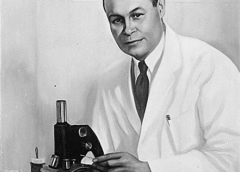Charles Richard Drew was an American surgeon and medical researcher. He was born on June 3, 1904 into a middle-class African-American family in Washington, D.C. His father was a carpet layer and his mother was a teacher. Drew and three of his four younger siblings grew up in Washington’s largely middle-class and interracial Foggy Bottom neighborhood.
Drew won an athletics scholarship to Amherst College in Massachusetts,[7] from which he graduated in 1926
After college, between 1926 and 1928, Drew served as a professor of chemistry and biology, the first athletic director, and football coach at the historically black private Morgan College in Baltimore, Maryland, to earn the money to pay for medical school.
Drew attended medical school at McGill University in Montreal, Quebec, Canada, where he ranked second in his graduating class of 127 students, and received the standard Doctor of Medicine and Master of Surgery degree awarded by the McGill University Faculty of Medicine in 1933.
Drew’s first appointment as a faculty instructor was for pathology at Howard University from 1935 to 1936.
Drew researched in the field of blood transfusions, developing improved techniques for blood storage, and applied his expert knowledge to developing large-scale blood banks in the early stages of World War II.
This allowed medics to save thousands of lives of the Allied forces. As the most prominent African American in the field, Drew protested against the practice of racial segregation in the donation of blood, as it lacked scientific foundation, and resigned his position with the American Red Cross, which maintained the policy until 1950.
Beginning in 1939, Drew traveled to Tuskegee, Alabama to attend the annual free clinic at the John A. Andrew Memorial Hospital.
For the 1950 Tuskegee clinic, Drew drove along with three other black physicians. Drew was driving around 8 a.m. on April 1. Still fatigued from spending the night before in the operating theater, he lost control of the vehicle. After careening into a field, the car somersaulted three times. The three other physicians suffered minor injuries. Drew was trapped with serious wounds; his foot had become wedged beneath the brake pedal. When reached by emergency technicians, he was in shock and barely alive due to severe leg injuries.
Drew was taken to General Hospital in Burlington, North Carolina. He was pronounced dead a half hour after he first received medical attention. Drew’s funeral was held on April 5, 1950, at the Nineteenth Street Baptist Church in Washington, D.C.
A footnote:
Despite a popular myth to the contrary, once repeated on an episode (“Dear Dad… Three“) of the hit TV series MAS*H, Drew’s death was not the result of his having been refused a blood transfusion because of his skin color. This myth spread very quickly since during his time it was very common for blacks to be refused treatment because there were not enough “Negro beds” available or the nearest hospital only serviced whites. In truth, according to one of the passengers in Drew’s car, John Ford, Drew’s injuries were so severe that virtually nothing could have been done to save him. Ford added that a blood transfusion might have actually killed Drew sooner. (wikipedia)
Images:
Drew Mural: By Hugo L. González – Own work, CC BY-SA 4.0, https://commons.wikimedia.org/w/index.php?curid=65047326
Other Images and footage
wikipedia
Videoblocks
Pamela Marie from Pexels
Learn more about Dr. Charles R Drew…
https://web.archive.org/web/20031202014936/http://www.sbas.net/cdrew.htm
https://profiles.nlm.nih.gov/spotlight/bg
https://en.wikipedia.org/wiki/Charles_R._Drew

Rod is a blogger, writer, filmmaker, photographer, daydreamer who likes to cook. Rod produces and directs the web series, CUPIC: Diary of an Investigator. He is also the editor, producer and administrator of STM Daily News, a part of the TNC Network.


